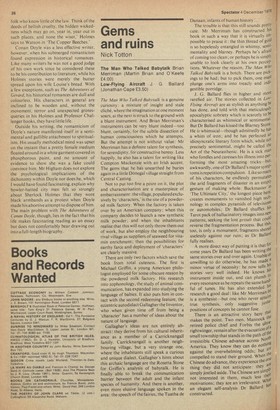A case of the missing author
Harriet Waugh
The Adventures of Conan Doyle Charles Higham (Hamish Hamilton
Z4.95)
The literature on Conan Doyle and his r'eation, Sherlock Holmes, is embarrassInglY extensive and too well documented for anYone to write yet another study of them. To this day outwardly sane civil servants dress up in plus-fours. deerstalkers and once 4, Year enact the fight to death between moriarty and Holmes. And there is a nice, s,adistic game which we played as children, Moriarty, where are you?' in which two ft,coPle are blindfolded and have to squat on tn.e ground and take swipes at each other With rolled up copies of The Times (other newspapers disintegrate too quickly). So though there is no publishing vacuum surrounding Doyle and Holmes, there is some sort of marshy patch in the market into which can throw any number of books on "le subject and they will, with a few sulphur gurgles, be quickly swallowed up and absorbed. People do appear to like to re:(.equaint themselves with facts with which `neY are already familiar. b There are few questions posed by Conan .°Yle's controlled and boringly unPicturesque life, but those which are remain _unanswered in this new biography by t?larles Higham. The main interest lies in bne.orising about the wraith-like, uneasy keing that seems to have existed somewhere c.neath his stocky, hearty exterior. But Mr hilghaM restricts himself to the minutiae of cilsubject's life, and to mentioning all the 6"erent Dr Watsons with whom Conan tbc:Y,Ie might have been familiar and who "gnt have christened Holmes's Boswell. Such tantalising strands as Doyle's necrophiliac tendencies are mentioned only to be passed over as quickly as it takes to say Jack the Ripper. The pugnacious, moustachioed and rather over-stuffed face that stares out from the cover of the book keeps its secrets and the curious, unblended strands in his nature are mentioned but not explored. Inside that conventional Victorian hearty who loved whaling, travelling and fishing, who liked middle-brow literature and was easily moved to patriotic feeling, there was a romantic who was disillusioned by the lack of dragons and knightly quests in midVictorian industrial England.
Doyle's imagination had been possessed by the Arthurian legend in early childhood and was fuelled by his mother's attachment to it. During his most open and formative years, his and Mrs Doyle's imaginative feelings were so sympathetically fused that her influence over him never waned. However, poor Mr Doyle, the runt of an artistic family, was given to fits, drink, drawing bad pictures, melancholia, drugs and breakdowns—none of which helped expiate his wife and son's romantic longings. At the age of fourteen Conan Doyle became aware of a less fey aspect of the fight between good and bad when he visited Madame Tussaud's. The Chamber of Horrors (now sadly changed) gave him an authentic thrill of evil. With this background, it is hardly surprising that he should have created a latter-day knight, in the form of a chaste detective, fighting alone against the incalculable cupidity, evil and moral defectiveness that he saw as the inner drives of man— 'But look at these houses, each in its own fields, filled for most part with poor ignorant
folk who know little of the law. Think of the deeds of hellish cruelty, the hidden wickedness which may go on, year in, year out in such places, and none the wiser,' Holmes says to Watson in 'The Copper Beeches.'
Conan Doyle was a less effective writer, however, when his submerged romanticism found expression in historical romances. Like many writers he was not a good judge of his own work since he considered these to be his contribution to literature, while his Holmes stories were merely the butter spread upon his wife Louise's bread. With a few exceptions, such as The Adventures of* Gerard, his historical romances are dull and colourless. His characters in general are inclined to be wooden and, without the movement, terror and unexpected grotesqueries in his Holmes and Professor Challenger books, they have little life.
Outside his writing, the romanticism of Doyle's nature manifested itself in a sentimental and gullible attachment to spiritualism. His usually methodical mind was upset on the instant that a pretty female medium floated around in a white garment covered in phosphorous paint, and no amount of evidence to show she was a fake could convince him. Mr Higham does not explore the psychological implications of the dichotomy within Doyle nor does he, which I would have found fascinating, explain why bowler-hatted city men felt so strongly about Sherlock Holmes that they wore black armbands as a protest when Doyle made his abortive attempt to dispose of him. The main problem with The Adventures of Conan Doyle, though, lies in the fact that his life makes fascinating reading as an essay but does not comfortably bear drawing out into a full-length biography.







































 Previous page
Previous page